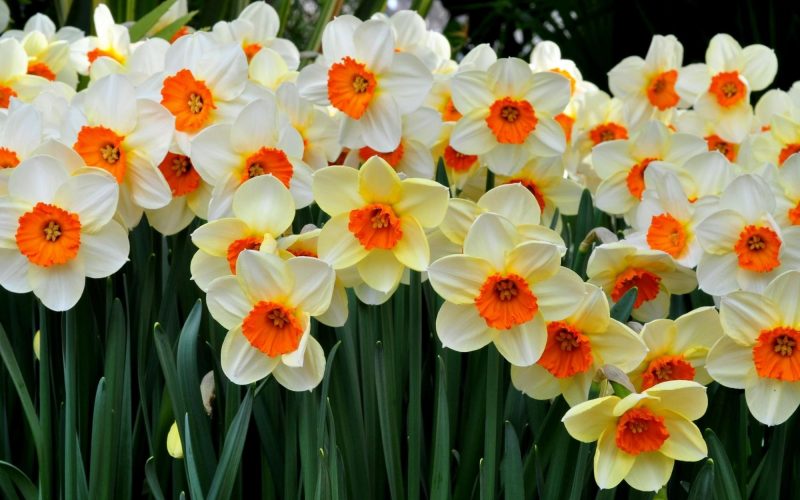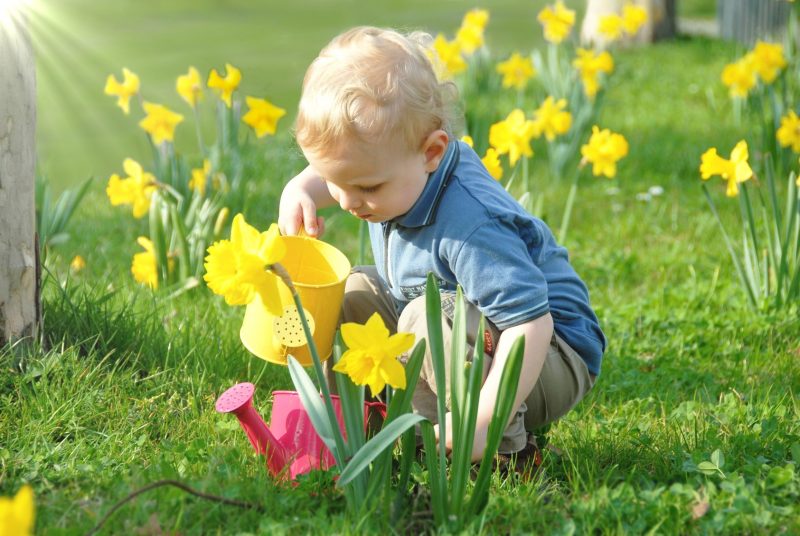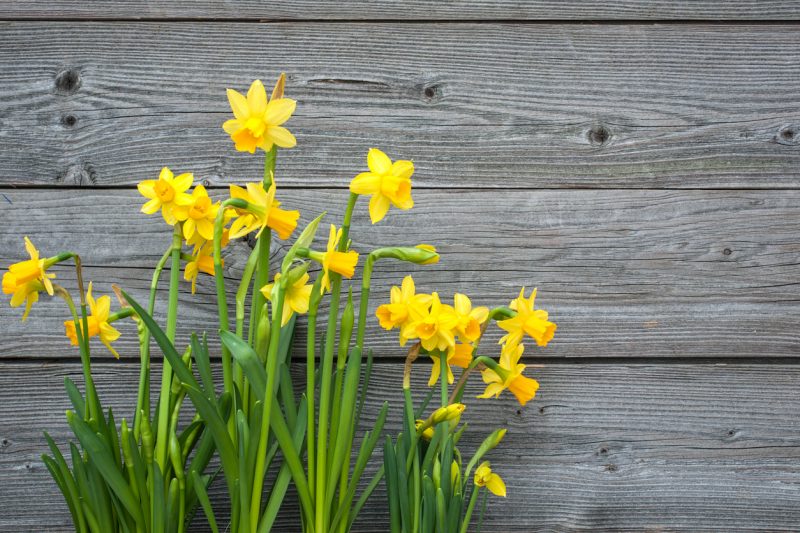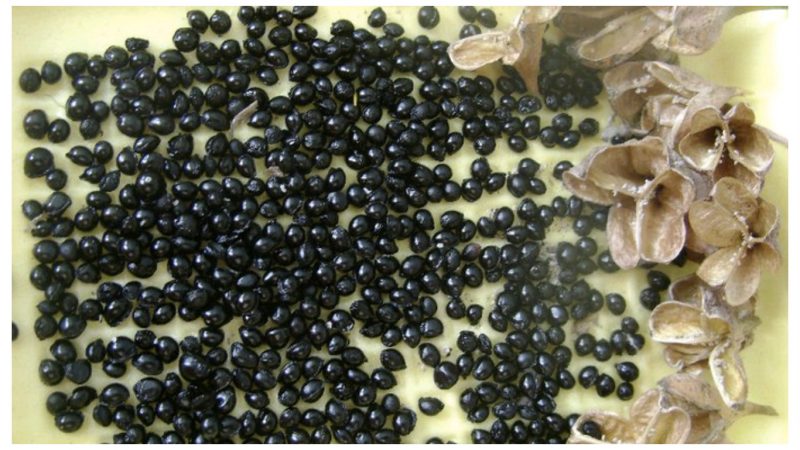Drawing in the imagination the image of spring, such an integral part as the flowering of daffodils always pops up. Fragile appearance and delicate aroma captivate the hearts of connoisseurs of flowers. A simple planting and care of daffodils in the open ground made him a favorite among all summer residents who want to decorate the spring garden with elegance and bright colors.
Material Content:
Outdoor daffodil planting

These flowers appear among the first in the front garden, like crocuses and tulips, while being considered the most unpretentious bulbous plants. However, in order to grow a daffodil bright and attractive, one should even competently approach the initial stage - planting.
Location and soil
An important point is the choice of territory for planting bulbs, taking into account the soil composition. An ideal option would be a well-lit area with neutral loamy soil, where nitroammophoska is added at the rate of 60 g per 1 m2, compost or humus. The excess alkali in the soil is neutralized with dolomite flour at the rate of 200 g per 1 m2, and the increased acidity level is reduced by adding one glass of wood flour to the same area.
Advice! Do not place daffodils after other bulb crops - tulips, lilies. Optimum precursors are cereal, bean and solanaceous representatives.
Selection and preparation of planting material
Flower shops present a wide assortment of daffodil bulbs of various varieties, which are often sold at large discounts in the spring due to stale goods.

When choosing bulbs, it is recommended to pay attention to:
- integrity and absence of decayed areas;
- size - with a diameter of less than 5 cm, the bulb must be grown, which will slow the germination;
- hardness.
Before landing, a thorough inspection is carried out and damaged, stubborn material is discarded. Healthy bulbs are disinfected with a fungicidal agent or a solution of potassium permanganate with a concentration of 1%
Advice! It is better to make a purchase of planting material three months after the completion of blooming flowers.
When and how to plant daffodils?
Daffodils land depending on the climate of the region. The basic rule is soil temperature from 8 to 10 ° C, which lasts for three weeks until the flower takes root.
Typically, bulb crops are planted in the fall. You can plant the bulbs in the spring, be sure to keep them in the refrigerator for two months in advance, so that the daffodils take root and bloom in the same year.
- Landing in the spring. Wells are dug at a distance of 10 cm, subject to future seating, and 20 cm if further growth of flowers is planned in the next five years. Before placing the bulbs in the planting pit, sand is poured to improve the drainage qualities of the soil. After planting, garden soil is mulched with sawdust, straw or mowed grass 3-4 cm thick. This will save the grower from unnecessary weeding, loosening and protect the soil from weathering.
- Landing in the fall. In the autumn, the bulbs are planted according to the same principle as in the spring. After the advent of frost, the plot with flower bulbs is covered with leaf from fruit trees or nuts.
Important! When calculating the depth of the hole, the diameter of the bulb, which is multiplied by three, is taken as the basis.
Daffodil Care
The quality of care affects the production of beautiful, elegant spring flowers with delicate aromatic notes.
Watering and loosening

In arid weather conditions from the end of spring, daffodils need regular hydration during the existence of the aerial part of the plant: after flowering is completed, watering allows the bulb to accumulate more nutrients. If the site is not mulled, after each irrigation, the beds need loosening and weeding.
Temperature
Air and soil temperature conditions affect the beginning and duration of the flowering phase. The optimum temperature values are 15 ° C for air and 10 ° C for soil.
Fertilizer application

When cultivated in the front garden, early spring flowers need twice feeding:
- The introduction of a complex of mineral fertilizers into the budding phase is organized: at a flow rate of a working solution of 5 l per 1 m2 in 10 l of water, superphosphate, potassium sulfate and urea are diluted (one teaspoon of each substance).
- Special fertilizer for flowering plants is being added with the addition of nitrogen, phosphorus and potassium: two teaspoons of Agricol and one nitroammophos are bred in 10 liters of water.
In rainy weather, liquid top dressing is replaced by a single application of dry fertilizers in early spring - per 1 m2, one teaspoon of potassium sulfate, superphosphate, urea and one tablespoon of wood ash.
Pest and Disease Control
The culture is affected by Fusarium, rot, and is also populated by a daffodil fly, tuberous and onion gulls, onion and root ticks, slugs, nematodes.

As protective measures, a double treatment of plants is carried out:
- Before the formation of buds, spraying with insecticide and acaricidal preparations is organized according to the manufacturer's instructions.
- Upon completion of flowering, the daffodils are treated with a solution of copper sulfate at the rate of 100 g of substance per 10 l of water, at a flow rate of 2 l of working fluid per 10 m2, or with the HOM preparation with the same flow rate prepared by diluting 40 g of the product in 10 l of water.
Transfer
If the florist noticed that the flowers have become smaller and worse in terms of quality indicators, it means that there is a need to transplant daffodils. When transplanting, a vegetative method of propagating the culture is used - dividing the bulb.
Read also:when to dig daffodils
Care after flowering
Depending on the gardener's plans, two algorithms are possible:
- If the bulbs are left in the soil for further growth, it is necessary to cut off the ground part after drying, loosen the soil and clear of weeds. In the second half of August, subject to drought, it is necessary to water the plot: the bulbs begin to form new roots.
- In case of transplantation or propagation, a digging of planting material is carried out. But you need to know when to dig the bulbs. Their harvesting begins after the natural wilting of the leaves, usually in July.
Advice! If the grower has decided to dig out the bulbs, then you should not overly delay the time after yellowing the leaf plates: the daffodils quickly begin to take root.
Breeding methods
Two methods are used to breed daffodils: vegetative and seed.
Vegetative Method
During the growing season, an average of two to four is formed from one bulb.

If you want or need to get new copies, you should adhere to the following steps:
- The dug out mother bulbs, together with the daughter ones, are cleaned of wilted residues.
- Planting material is inspected for rejection and destruction of diseased or damaged bulbs.
- Healthy specimens are peeled, washed, disinfected for half an hour in a 1% solution of potassium permanganate, and then divided.
- First, the specimens are separated, falling off without effort, and those that are firmly pressed to the mother ones, swing for independent separation.
- If the bulb comes off, the fault is sprinkled with charcoal or activated carbon.
- Then, the separated specimens are dried in a shaded place and stored in a room with a constant temperature of no higher than 17 ºC.
Attention! Do not delay the time before planting: after a time, moisture loss by bulbs is noted. The optimal storage interval from excavation to planting is two months.
Seed method

The method consists in sowing freshly picked, not properly dried seeds at the height of the summer season or late autumn as follows:
- Seeds are not sown too densely in a box or open ground to a depth of three seed diameters.
- During the first two years, seedlings are not worried, which allows the bulb to grow stronger.
- At the end of two years of rest, young specimens are planted at a permanent place of growth.
For the first time, such daffodils form buds after at least three years.
Attention! The seed method is permissible only for wild-growing varieties: with this method, varietal qualities are not inherited by new specimens.
So, observing a number of simple rules for growing daffodils, each grower will enjoy the spring tenderness of his garden.












